21 fine wines for 12: Yep, I am back in DC for a fantastic wine dinner
December 28, 2012
A fine tasting of vintages in the shadows!
It was great to join old friends and fellow wine lovers in Washington D.C. one week after arriving here from France. I have to say – yet again – I sometimes drink better here than in France.
In one evening… we had 21 truly fine wines for 12 people!
Thanks ever so much to Ken Barr, Howard Cooper, Randy McFarlane (and wife Caroline, for the ride to the restaurant), Chris and Marjorie Bublitz, Ben Giliberti, Adelaide and Karl Kellar, Darryl Priest and wife Nancy, and David Zimmerman. A dandy time was enjoyed by all. And once again at Lavandou, the ever-ready-to-serve-you BYOW in Washington D.C. Service is excellent, the food is great, and prices more than reasonable. What more can a wine and food lover wish for?
Let’s get to the notes… as always bold I liked in particular, red and bold even more and when underlined, the very best!
Bubblies
J.L. Vergnon Blanc de Blancs Grand Cru Brut “Conversation”: Never heard of this wine before that Randy bought just before the dinner and it proved quite a nice surprise. Stone like aromas, chalky, with a bright attack, taut on the mid palate, with some subtle if slightly sweet richness following this, finishing fresh. A fine discovery, and for the price (under $50), quite an excellent deal.
Krug Brut. Tasting this reminds me yet again why this Champagne is considered a Rolls Royce. Toasty nose, but balanced by fruit and freshness, minerality. The attack is velvety yet strong, brisk, with a deep mid palate that envelopes one’s senses, and ends on a lingering finish that beckons yet another sip… Lovely.
Nicole Maillart Premier Cru Extra Brut Blanc de Noirs “Les Francs de Pied” 2005: Another Champagne that Randy also purchased just before dinner, a vintage wine that is double the price. A very pure nose, red fruit (strawberry, raspberry), with a substantial mid palate albeit slight metallic notes, and a finish that is somewhat abrupt, coming after the Krug. I liked this wine, but felt as if it was somewhat closed down, especially on the finish – and yet, there is evident purity on the nose and substance on the mid palate. Costs about the same as a Krug Brut, so I would opt for the former, in terms of pricing.
Dry whites
Chateau Carbonnieux Pessac Leognan 2001: Ah, what a lovely wine. Herbal, lemongrass, slight lanolin but not overbearing, a touch of acacia and again citrus aspects echoed on the fresh and medium plus bodied palate that was subtle in the way it pleased one’s senses. The finish lingered but without ostentation. It had an iodine freshness, and yet fine presence, still quite youthful in fact. No wonder 2001 is considered to be such a fine vintage for Graves whites in Bordeaux. Exemplary.
Chateau Pape Clement 1999: Here we have the Bernard Magrez methodology of far more oak, and in a vintage that was far more challenging than 2001. The color looked older, the wine smelled just a bit like Sherry. But it was not oxidized, perhaps just past its prime? The palate was better: rich and substantial still, quite palate coating in fact and pleasing on the mid palate especially. But it lacked the freshness factor, and even though the terroir of Pape Clement is likely superior to that of Carbonnieux, the above wine had more nuance to it.
Next came a fine series of reds, the majority from “in the shadows” vintages… years that are overshadowed such as 1978 (overshadowed by 1975 to some extent and certainly by 1982), 1988 (overshadowed by 1989 and 1990) and 1999 (overshadowed by 1998 – at least on the Right Bank – and of course 2000). But we were often pleasantly surprised. And in this day and age of hyper-pricing for more recent Bordeaux vintages, it is always a good idea to seek out somewhat forgotten vintages whose drinking windows are wide open and whose prices tags weigh less on your wallet.
Two 1978s
Domaine de Chevalier Pessac Leognan 1978: Lovely tobacco nose, dry tobacco with graphite with truffle like touches beckon the palate. The attack is supple with dried herbs (thyme?) and more tobacco, conveyed in a medium body that is not loose knit but open for drinking pleasure. The finish is of moderate length, but seductive in its aromatic echoing of what one would expect from a Graves. Refined and delicious.
Pichon Longueville Comtesse de Lalande Pauillac 1978: Initially a Band-Aid aroma (while the Domaine de Chevalier was put in a carafe for about one hour before drinking, the Pichon was popped and poured – although it had been opened previously, and I am not sure if Ken Barr, who brought it, double decanted earlier). In any case, that aroma blew off to reveal a robust nose of cassis and cedar – more youthful than the Domaine de Chevalier. The palate was opulent, although one could sense a slight hardness to the tannins, but ever so, and in the end – after David Zimmerman asked me which of the two 1978s would last longer – I think the Pichon would be a longer lasting wine, as it seems to have more substance than the Domaine de Chevalier, which I found more pleasurable today however.
Two 1988s
Calon Segur St Estephe 1988: A very cedar nose, precise, followed through on the palate with what Ben called “coiled energy” now unleashed. I brought the bottle and the fill level was not ideal, and it seemed a bit jagged at first (popped and poured), but time in glass increased the substance one felt on the palate – a very excellent presence, quite full-bodied in fact, that made this wine appealing, although I have had better examples of this wine in this vintage.
Rausan Segla Margaux 1988: If I recall correctly the estate was still using an “s” in Rausan in 1988 whereas they later changed that to a z. Important details. Almost jammy in comparison, on the nose, and immediately more pleasurable on one level, with evident fruit aspects. But the palate is more diffuse, not as precise or – in the end – as interesting as the Calon Segur. Still, this provided pleasure, although I noticed that the bottle of Calon was empty by the end of our tasting whilst the Rausan was not.
Two 1999s
Lynch Bages Pauillac: The nose was quite youthful, still rather primary in its cassis and dark fruit profile although there was also lead pencil. The attack was frank and substantial and the mid palate even more so, leading to a surprisingly tightly wound aspect on the finish: a backward 1999? As it sat in glass, the richness started to shine through, reminding us all that Mouton Rothschild is a rich man’s Lynch Bages… A very impressive showing by this Pauillac.
Rauzan Gassies Margaux: The nose was also quite fruit driven, the attack is softer – this is Margaux ☺ – and the mid palate is medium bodied, with a pleasurable palate presence but lacking the substance of the Lynch Bages. I would not say that this wine is foursquare, but it lacks a bit of oomph. Then again, it was quite tasty.
A 1986 interlude
Chateau Talbot St Julien 1986: Here we have a vintage that is not “in the shadows”, considered to be among the very best from the 1980s. A large scaled tannic vintage that has softened by now, but still has a full-bodied aspect that charms you like a St Julien should. There is a long finish to this wine, too. Some “Cordier” funk to it, as expected, but cleaner than I would have thought. Terrific juice!
A 1962 interlude
Chateau Branaire Ducru 1962: Talk about an in the shadows vintage. Coming after 1961, this is rather forgotten, but not by wine connoisseurs like the group of people I met for dinner! They know their Bordeaux. I have had few examples of the 1962 vintage but almost every time, it pleases. I recall a double magnum of Gruaud Larose which was brilliant. This wine was just subtle and refined, and soft. The palate reminded me of a humidor for Cuban cigars, very tertiary and quite earthy but not tired. It had a supple attack and a soft mid palate of moderate intensity, with a smooth and clean finish. It wowed me more with its delicacy than by anything else, other than the fact that it was half a century old and still quite fine!
Palmer 1999 – Margaux 1999 – Margaux 1988
A fine way to end the reds with the two great Margaux wines… We began with the Chateau Palmer 1999, which exuded perfumed freshness, orange rind, yet also red fruit and minerality: a complex nose. The palate was at once opulent, yet rather taut, quite youthful in fact, and not really open for business. Particularly noted on the finish. But the mid palate was suave and substantial, and I just really loved this Palmer. If you own one, wait a couple of years… although we have had examples of the 1999 that are more open knit.
Of a different style – here we have more Cabernet – was the equally (and perhaps more) impressive Chateau Margaux 1999. Chris Bublitz who brought this wine included the price tag of $159 (he actually paid about $139) to show just how much higher the first growths have gone in price. He paid that amount in 2005, if I recall correctly. I wrote “lead pencil city” on my notes sheet… but it was not just that. There was distinct polish to the palate that made it more refined than the Palmer, which relied on greater opulence for its appeal. This stately quality in the Margaux was accentuated by very good ripeness of the Cabernet fruit, better than expected in fact (although I recall being rather pleased with the 1999, tasted at the chateau along with the 1997, 1998 and 2000, back in late summer 2001). Like the Palmer, the Margaux 1999 is still on a rather youthful phase in its evolution and if you own it, I would not bother for at least another five years.
Chateau Margaux 1988: For some reason, I could not bring myself to like this wine as much as others at our table. Did it have too much acidity for its own good? Strangely it made me think of how a 2008 Margaux may taste in 20 years. I was not a fan of 2008 Margaux, except for a handful of estates, including Palmer. Let’s look at the positives however: there were expressive notes of darker fruit, forest floor and tobacco (wet) aspects, with some plucky freshness, and just ripe enough plum. Yes, it is sprightly and perhaps it will mellow, but I found the acidity to be obstructive rather than complementary for my taste.
Late harvest Sauternes-Barsac
Flight One
Climens Barsac 1978: This may be my candidate for wine of the night. Caramel of the finest quality, with a curious mélange of dried fruit and juicy apricot, leading to a supple yet assertive attack and expanding mid palate, full of black tea-like flavors, a sure sign of botrytis whose expression has been mellowed with over 30 years in (half) bottle. An absolutely lovely wine.
Climens 1998: Here I was also impressed but less so because the sheer complexity of the 1978 blew the 1998 out of the water – for now. Another half bottle and the feeling was more jammy and fruity and rather evident, but there was fine acidity and freshness too. I just kept going back to the 1978.
Flight Two
Chateau d’Arche 1988: Wow what a surprise! The color was very youthful, and the flavors of toffee and white fruit with even a mineral aspect proved very pleasing indeed. Lacked perhaps the intensity and depth of the Climens but it was oh so smooth, and I came back to this one, too. Excellent.
Chateau Raymond Lafon 1988: Now the color was darker and the taste was more evolved, and I have had better examples of this grand vin… Chris Bublitz brings this to tastings rather often and thanks to that, I know that this wine can be better in this vintage but the darker caramel notes were telltale. For some reason, I did not take any serious notes for this, but it was not as impressive as the d’Arche, by virtue of its speedier evolutionary track – for this bottle/cork.
Finale
Chateau de Fargues 1983: Here a dark color as well, but not so much different from the five-years-younger Raymond Lafon. The nose was very orange marmalade like, hints of ginger, and the palate rich and full bodied with good tension, and of course opulence one expects from a Sauternes in a great vintage like 1983. Finishing on spicy botrytis-derived notes, this was another excellent pleasure to drink!

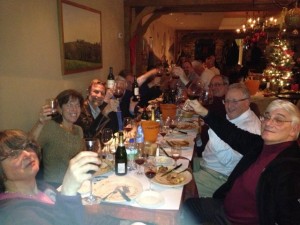
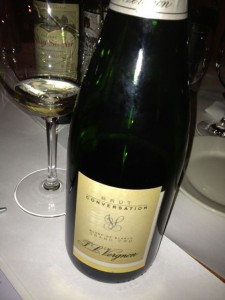
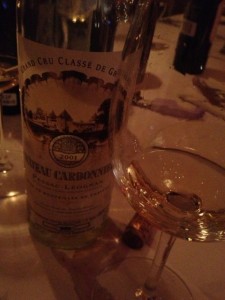
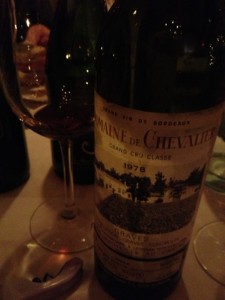

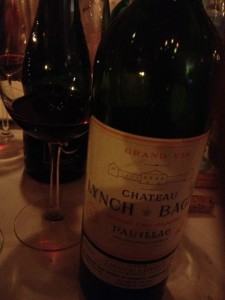



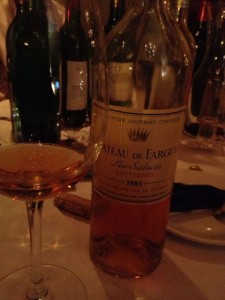
[…] just one day after a tasting dinner with fellow wine lovers in Washington D.C. to taste overlooked vintages in Bordeaux, this evening featured the single vintage of 1998 across France. Very happy crew at Ian's […]